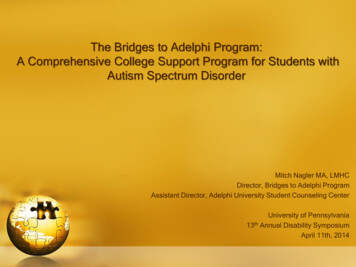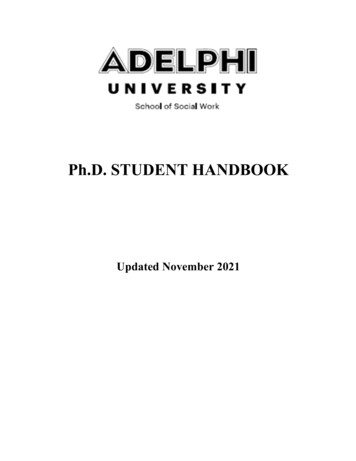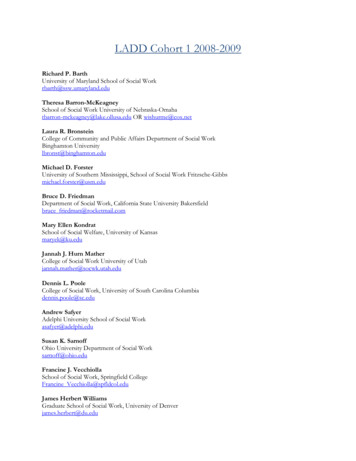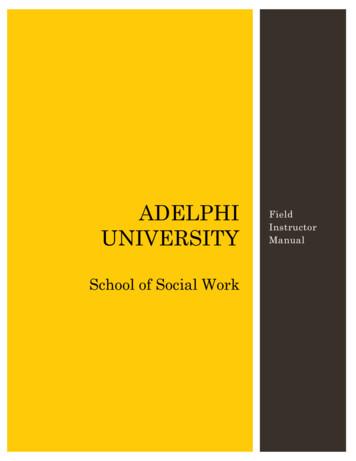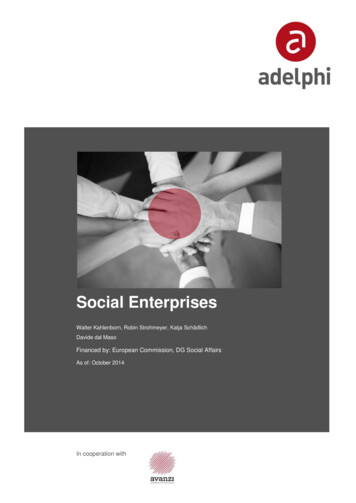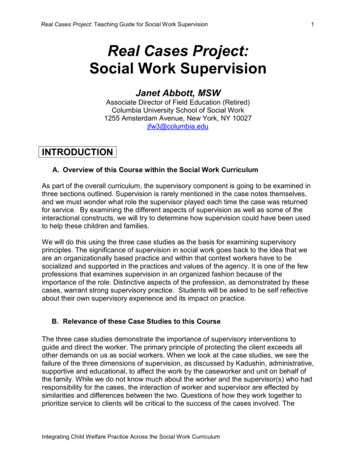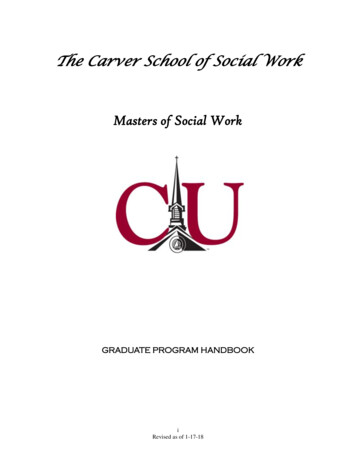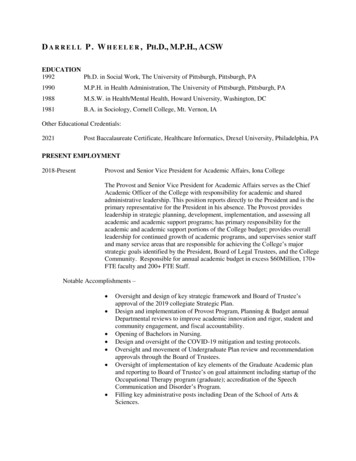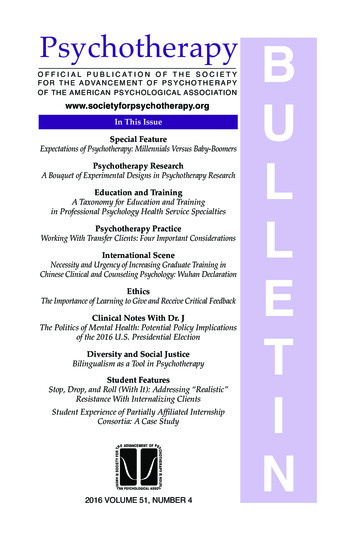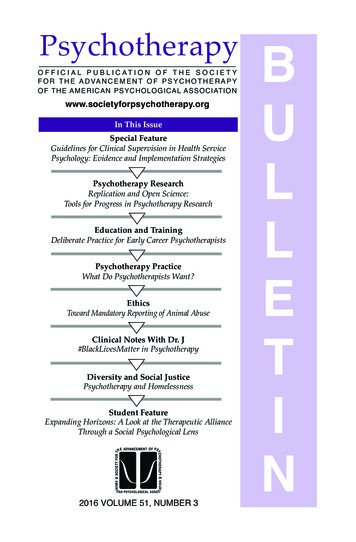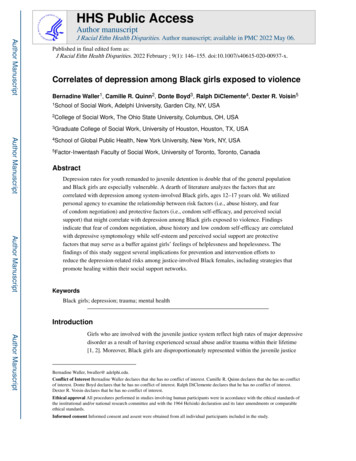
Transcription
HHS Public AccessAuthor manuscriptAuthor ManuscriptJ Racial Ethn Health Disparities. Author manuscript; available in PMC 2022 May 06.Published in final edited form as:J Racial Ethn Health Disparities. 2022 February ; 9(1): 146–155. doi:10.1007/s40615-020-00937-x.Correlates of depression among Black girls exposed to violenceBernadine Waller1, Camille R. Quinn2, Donte Boyd3, Ralph DiClemente4, Dexter R. Voisin51Schoolof Social Work, Adelphi University, Garden City, NY, USA2Collegeof Social Work, The Ohio State University, Columbus, OH, USA3GraduateAuthor Manuscript4SchoolCollege of Social Work, University of Houston, Houston, TX, USAof Global Public Health, New York University, New York, NY, USA5Factor-InwentashFaculty of Social Work, University of Toronto, Toronto, CanadaAbstractAuthor ManuscriptDepression rates for youth remanded to juvenile detention is double that of the general populationand Black girls are especially vulnerable. A dearth of literature analyzes the factors that arecorrelated with depression among system-involved Black girls, ages 12–17 years old. We utilizedpersonal agency to examine the relationship between risk factors (i.e., abuse history, and fearof condom negotiation) and protective factors (i.e., condom self-efficacy, and perceived socialsupport) that might correlate with depression among Black girls exposed to violence. Findingsindicate that fear of condom negotiation, abuse history and low condom self-efficacy are correlatedwith depressive symptomology while self-esteem and perceived social support are protectivefactors that may serve as a buffer against girls’ feelings of helplessness and hopelessness. Thefindings of this study suggest several implications for prevention and intervention efforts toreduce the depression-related risks among justice-involved Black females, including strategies thatpromote healing within their social support networks.KeywordsBlack girls; depression; trauma; mental healthIntroductionAuthor ManuscriptGirls who are involved with the juvenile justice system reflect high rates of major depressivedisorder as a result of having experienced sexual abuse and/or trauma within their lifetime[1, 2]. Moreover, Black girls are disproportionately represented within the juvenile justiceBernadine Waller, bwaller@ adelphi.edu.Conflict of Interest Bernadine Waller declares that she has no conflict of interest. Camille R. Quinn declares that she has no conflictof interest. Donte Boyd declares that he has no conflict of interest. Ralph DiClemente declares that he has no conflict of interest.Dexter R. Voisin declares that he has no conflict of interest.Ethical approval All procedures performed in studies involving human participants were in accordance with the ethical standards ofthe institutional and/or national research committee and with the 1964 Helsinki declaration and its later amendments or comparableethical standards.Informed consent Informed consent and assent were obtained from all individual participants included in the study.
Waller et al.Page 2Author Manuscriptsystem where high rates of depression are reported [2, 3]. Although Black youth comprise18% of the overall population in the United States, Black girls account for 35% of theover 48,000 youth within the juvenile justice system due, in part, to perceiving and treatingthem as harshly as adults rather than youth [3, 4]. This is in stark contrast to their Whitepeers who are significantly underrepresented in the juvenile justice system [4]. Accordingto the Georgetown Law Center on Poverty and Inequality, Black girls are 2.7 times morelikely to be referred to juvenile justice, 0.8 times less likely to have their cases divertedand 1.2 times more likely to be detained than White girls [3]. Although Black girlsgenerally underreport depressive symptomology, they are at particular risk since they areoverwhelmingly represented among girls of all racial/ethnic backgrounds who are systeminvolved [1, 3]. An important step toward reducing rates of depression among Black girlswho are juvenile justice-involved is understanding what factors are correlated with theirdepressive symptomology.Author ManuscriptDepressionAuthor ManuscriptDepression among youth within the juvenile system continue to rise and Black girls’disproportionate presence underscores their elevated risk [3, 5]. Depression rates amongsystem-involved youth is double that of the general population [1, 6], and of those whoare system-involved girls’ depression rates are double that of boys [1]. Moreover, detentionrates increase the likelihood of a major depressive episode among system-involved girls[7]. Girls in detention are more likely than boys to experience depression as a result oftrauma and exposure to other adverse childhood experiences (ACEs), interaction with thechild welfare system prior to system involvement, and childhood delinquency, as well asincreased likelihood of internalizing behaviors and fears related to their detention [1, 2].As detention rates of Black girls continue to escalate, the numbers of those experiencinga major depressive episode have also increased [3, 5]. In fact, more than half (54%) ofBlack girls in detention report experiencing depressive symptomology [5]. Goodkind etal. [6] examined 186 girls involved with the juvenile justice system found that girls whohad histories of physical and/or emotional abuse and no family support are more likely toexperience depression. Moreover, Black girls are more readily given harsher sentences thanWhite girls [3]. Rather than remanding Black girls within home or open residential settings,they are typically detained in closed residential settings, which elevates the likelihoodthey will experience depression [6]. Notably, Black girls’ intersectional social location,specifically their gender and ethnicity, often precludes them from receiving the treatmentthey need to improve their overall health and wellbeing while in the justice system [8].Trauma History and History of AbuseAuthor ManuscriptTrauma and adverse childhood experiences (ACEs) are evidenced among Black girls withinthe juvenile justice system. Girls within the juvenile justice system reflect the highestprevalence and multiple exposures to ACEs prior to their interaction with the system andBlack girls are particularly vulnerable [9]. ACEs include any physical, sexual or verbalabuse; neglect and/or household dysfunction, namely family violence, mental illness orincarceration as well as separation or divorce [10]. Recent research that examined racialdifferences from the National Survey of Children’s Health 2016, which is a nationallyrepresentative sample of all youth, ages 0–17, reveals that Black children are more likelyJ Racial Ethn Health Disparities. Author manuscript; available in PMC 2022 May 06.
Waller et al.Page 3Author Manuscriptthan White children to experience at least two ACEs [11]. Existing literature points to acorrelation between ACEs and system involvement among youth. Specifically, 62% of girlswithin the juvenile justice system report that they have experienced at least four typesof ACEs [9]. This is an issue among Black girls since both girls and Black children aremore likely to report experiencing ACEs [9]. The sequela of trauma experiences are furthercompounded once they are system-involved and experience the psychological distress ofprocessing and/or confinement [12, 13].Self EsteemAuthor ManuscriptSelf-esteem is a concept that denotes the way individuals feel about and/or value themselves,which is related to depression [14]. Some of the established factors associated with selfesteem include peer influences like peer acceptance and family relationships [15], whichare also associated with their sexual behaviors [16]. Self-esteem has been associated withmore positive mental health outcomes [17]. However, low self-esteem has been associatedwith a greater probability of exhibiting sexual risk behaviors [18] along with early sexualdebut [19]. Yet, findings from another research study suggest that higher self-esteem wasnot associated with age of sexual debut [20]. Further, Penfold and colleagues [21] didnot find any relationship between self-esteem and sexual risk behaviors (i.e., having hadsexual relations at an early age). A dearth of literature examines self-esteem among systeminvolved Black girls [22, 23]. However, the literature does note that positive self-esteem mayinfluence girls’ motivation to improve their overall quality of life [23], despite their elevatedrisk for experiencing depression due to their histories of trauma [22, 24]. This warrantsfurther examination of the relationship between self-esteem and depression among Blackgirls who are system-involved.Author ManuscriptCondom Negotiation and Self-EfficacyAuthor ManuscriptGirls’ ability to ensure condom utilization during sexual intercourse evidences a senseof sexual self-efficacy [25, 26]. Sexual self-efficacy (SSE) is postulated as the level ofconfidence and perceived control that a person has over her own sexual outcomes duringintimacy with her partner [25, 27]. It has been operationalized to elucidate girls’ interest,desire, arousal and orgasm within their sexual relationships. SSE reflects girls’ level ofself-sufficiency and confidence during sexual encounters [28, 29]. SSE is an extension ofself-efficacy, which is posited as one’s belief in her own ability to control the outcome ofa situation [30]. Both theories elucidate the positive correlation between this population’sperception of control and the ways they feel empowered to employ strategies to respondduring sexual encounters. As such, girls who reflect low SSE and poor condom negotiationskills contract a range of sexually-transmitted infections, including HIV, and/or becomingpregnant [25, 31].Social SupportThe view that an individual is appreciated and acknowledged in their social environmentenhances their well-being, including their self-efficacy, self-esteem and confidence thatguards against depression [32]. Perceived social support, operationalized with respect to thequality of a given relationship, is one of the most robust concurrent predictors of depressivesymptomology [33]. Research on social support suggests that associations with higher levelsJ Racial Ethn Health Disparities. Author manuscript; available in PMC 2022 May 06.
Waller et al.Page 4Author Manuscriptof depressive symptoms in adolescents found that lower parental support was associatedwith depressive symptoms [34]. Adolescent girls who possess fewer social supports aremore likely to rely on specific relationships, i.e., romantic relationships. Specifically,adolescents are more vulnerable to developing depressive symptoms when parents areabsent and unable to assist them with regulating emotions that are often associated withthe stress of romantic experiences [35, 36]. Further, research showing the principles ofcommunal cultures of Black/African Americans, and their greater belief in family andkinship networks for social support [37-39]. One previous study with a sample of Blackand Afro Caribbean girls from the National Study of American Life-Adolescent surveyresults suggested that high levels of perceived peer support was associated with low levels ofdepressive symptoms, while parental support (i.e., perceived maternal and paternal support)did not mediate depressive symptoms [32]. To this end, assessing Black girls’ depressionsymptoms based on their social support from peers and parents is a critical factor inpromoting protective factors that improve their psychological well-being.Author ManuscriptPersonal AgencyAuthor ManuscriptPersonal agency is a key aspect to understanding how an individual uses her power toengage in intentional decision-making based on information accessible to her [40-42].Personal agency illuminates the ways that girls are actively involved in implementing theirbeliefs to ensure a predetermined outcome and comprises two dimensions: perceived controland self-efficacy [42, 43]. Perceived control is postulated as the amount of control girlshave over their behaviors and is influenced by environmental factors that may preclude theirability to complete their predetermined actions [43]. Self-efficacy is posited as girls’ abilityto perform specific actions [30, 43]. Personal agency has been used to inform the behaviorof Black youth, including girls in the context of sexual risk behaviors, i.e., HIV testing,etc. [40, 44]. Investigating different aspects of an individual’s agency must be consideredwith other salient factors to understand their overall mental health and well-being. Withinthe context of the current study, we seek to examine the role that personal agency andindividual, parent and peer factors play in regard to depression among justice-involved Blackgirls. Specifically, is personal agency a protective mechanism against depression amongBlack girls (12–17 years old) exposed to trauma? By prioritizing their personal agency, wecan highlight how Black girls engage in acts of resistance (or lack thereof) that may notalways be evident [45].MethodsParticipantsAuthor ManuscriptThe current study used data from the Imara parent study, a randomized controlledstudy designed to test the efficacy of a sexual risk reduction intervention to decreasethe incidence of sexually transmitted infections, improve HIV-preventive behaviors, andenhance psychosocial outcomes for Black females in a juvenile detention center [40, 44-48].Eligibility criteria for the study participants consisted of girls who self-identified as Blackor African American, were ages 12–17, were currently incarcerated in short term detentionfacility in Atlanta, Georgia, who self-reported having vaginal intercourse prior to detention,not in steady relationships, and were not pregnant or wanting to be pregnant [46]. AdditionalJ Racial Ethn Health Disparities. Author manuscript; available in PMC 2022 May 06.
Waller et al.Page 5Author Manuscriptinformation about the full efficacy study is described elsewhere [47]. Data for this studywere drawn from the baseline data.ProceduresAuthor ManuscriptConsent and assent in the parent study was obtained from participating girls and theirparents respectively prior to the implementation phase of the study. Data collection wascompleted while girls were still in detention, including 93% (N 188) of the eligibleparticipants enrolled in the study were included in the current study. The study participantscompleted surveys using audio computer-assisted self-interviewing (ACASI) technology.ACASI has shown to reduce selection bias and may help with literacy problems andtouts numerous benefits, including its ability to be self-administered, recognition ofinconsistencies in the client’s self-report prompting them to resolve the discrepant data whilealso enhancing confidentiality and accurate recall using timeline follow-back techniques [49,50].MeasuresThe measures used in this study were selected based their previous use, which was validatedwith this population [51].Dependent variableAuthor ManuscriptDepression: Depression was assessed using the Center for Epidemiologic StudiesDepression Scale (CES-D) [47, 52, 53]. Respondents were asked questions such as “I feltthat I could not shake off the blues even with help from my family and friends;” “I feltdepressed;” and “I thought my life had been a failure.” Response categories ranged from (1 less than a day, 2 1 to 2 days, 3 3 to 4 days, 4 5 to 7 days), where higher scoresindicate more depression. The Cronbach’s alpha for this scale is .91.Independent VariablesTrauma History: Trauma History [54, 55] was assessed using a 12-item, Yes/No index,which included questions such as, “In the past 12 months, did a friend die?” and “In the past12 months, was a family member a victim of a violent crime.” Scores ranged from 0 to 12,with higher scores indicating higher levels of exposure to traumatic events in the previousyear.Author ManuscriptHistory of Abuse: History of Abuse was a measure of cumulative childhood abuse thatis specific to abuse and does not include other types (e.g., neglect) of victimization.This measure was created in the parent study to invetigate participants’ demographic andbehavioral factors [44, 46]. Items have been used in prior research and measured threedichotomous variables: physical, emotional, and sexual abuse [48]. Participants respondedto questions such as “Have you ever been emotionally abused?” “Have you ever beenphysically abused?” and “Has anyone ever forced you to have vaginal sex when you didn’twant to?” Response categories were yes ( 1) or no ( 0). Responses were summed to a threepoint scale (Range 0.1–3.0) with higher scores indicating more abuse. The Cronbach’salpha for this scale was 0.66.J Racial Ethn Health Disparities. Author manuscript; available in PMC 2022 May 06.
Waller et al.Page 6Author ManuscriptSelf-Esteem: Self-Esteem was measured with 10 items from the Rosenberg Self-Esteemscale ([44, 48]; Rosenberg, 1965; α 0.843). Examples of items included “I feel that I havea number of good qualities” and “I feel that I am a failure” with response categories rangingfrom 1 to 4 (1 strongly disagree, 4 strongly agree), where higher scores indicated greaterself-esteem (Range 13–40). The Cronbach’s alpha for this scale was 0.90.Fear of Condom Negotiation: Fear of Condom Negotiation was measured with a 7-itemscale. Respondents were asked questions such as “I have been worried that if I talked aboutusing condoms with my boyfriend or sex partner he would ignore my request.” and “I havebeen worried that if I talked about using condoms with my boyfriend or sex partner hewould leave me.” Response categories ranged from (1 never, 2 rarely, 3 sometimes, 4 most of the time, 5 always), higher scores indicate higher fear of condom negotiation.The Cronbach’s alpha for this scale is 0.90.Author ManuscriptCondom Self-Efficacy: Condom Self-Efficacy was measured with a 9-item scale.Respondents were asked questions such as “How much of a problem would it be for you totake a condom off without spilling the semen?’; ‘How much of a problem would it be foryou to start over using a new condom if you placed it on the wrong way?’; and ‘How muchof a problem would it be for you to put a condom on a hard penis?”. Response categoriesranged from (1 never, 2 rarely, 3 sometimes, 4 most of the time, 5 always), wherescores indicate higher fear of condom negotiation. The Cronbach’s alpha for this scale is0.90.Author ManuscriptSocial Support: Social Support (family and friends/peers) was measured with an 11-itemscale. Respondents were asked questions such as “I get the emotional help and supportI need from my family” and “My friends really try to help me”. Response categoriesranged from (1 strongly disagree, 2 disagree, 3 neither disagree or agree, 4 agree,5 strongly agree), where higher scores indicate more family and friends support. TheCronbach’s alpha for this scale is 0.88.Covariate: Age was used a continuous variable.Data AnalysisAuthor ManuscriptUnivariate analyses were computed to describe all study variables (see Table 1). Next,bivariate correlation analyses (Table 2) were conducted to examine the associations betweenall study variables: depression, trauma history, history of abuse, self-esteem, condom selfefficacy, fear of condom negotiation, social support, and age. Next, a multiple regressionanalysis was conducted with all independent variables: trauma history, history of abuse,self-esteem, condom self-efficacy, fear of condom negotiation, social support, and age; onthe dependent: depression. Also, to test the hypothesis that the depression of juvenile justiceinvolved Black females are a function of multiple risk factors, and more specifically whethertheir depression moderates the relationship between condom self-efficacy and fear ofcondom negotiation a moderation analysis was conducted (Table 3). The authors conductedpost estimation test to check for multicollinearity between independent variables traumaJ Racial Ethn Health Disparities. Author manuscript; available in PMC 2022 May 06.
Waller et al.Page 7Author Manuscripthistory, history of abuse, as well as condom self-efficacy and fear condom negotiation; thevariance inflation factor was under 10 meaning there was no collinearity [56].Sample CharacteristicsThe analytic sample consisted of 188 Black girls between the ages 12–17, and the meanage was 15.32 (see Table 1). Fifty-six percent of girls reported low to moderate levels ofdepression (M 17.45, SD 17.67). In terms of the different types of abuse: 56% of girlsexperienced emotional abuse, 43% experienced physical abuse, and 24% experienced sexualabuse. Overall, Black girls experienced moderate levels of history of abuse (M 0.40, SD 1.10). Girls reported high levels of social support (M 42.61, SD 8.70) and moderatelevels of self-esteem (M 30.21, SD 5.73). They also reported low levels of efficacyaround condoms (M 19.40, SD 9.00) and fear of condom negotiation (M 8.46, SD 3.66). Among the overall sample, girls reported low levels trauma (M 3.91, SD 2.08).Author ManuscriptBivariate Correlation AnalysisAuthor ManuscriptMultiple RegressionAuthor ManuscriptTable 2. provides bivariate correlations between the primary study variables and the outcomevariable of depression symptomology. Results of the Pearson correlation indicated that therewas a significant negative association between history of abuse and depression symptoms (r .39, p . 001). There were negative relationships between social support and depression(r .31, p .001) and history of abuse (r .31, p .001). A positive correlation alsoexisted between condom self-efficacy and depression (r .16, p . 01) and history of abuse(r .26, p .001). Results also indicated a positive correlation between fear of condomnegotiation and depression symptoms (r .16, p .05), and history of abuse (r .25, p .01) and condom self-efficacy (r .24 p .001). Self-esteem was negatively associatedwith depression symptoms (r .33, p .01), history of abuse (r .39, p .01), condomself-efficacy (r .20, p .001) and fear of condom negotiation (r .33, p .01). Lastly,trauma history was positively associated with history of abuse (r .20; p .01).ModerationIn the multiple regression, variables included: trauma history, history of abuse, self-esteem,social support, age, and the interaction between condom self-efficacy and fear of condomnegotiation on depression. The model was statistically significant and the variablesaccounted for a significant amount of variance in justice involved Black girls, R2 .25,F (8, 179) 7.31, p .001. Our results revealed, that for every one-unit increase in historyof abuse there was 5.89 increase in depression (B 5.89, p .001). Social support wasfound to be statistically significant and negatively associated with depression (B .19, p .05) as was self-esteem (B .13, p .01). Condom self-efficacy was positively associatedwith depression among girls (B .36, p .01). Lastly, fear of condom negotiation waspositively associated with depression (B .68, p .042).Examination of the interaction plot showed an enhancing effect that as condom self-efficacyand fear of condom negotiation increased, depression among Black girls increased. Highfear in condom negotiation, and low condom self-efficacy was associated with Black girlsJ Racial Ethn Health Disparities. Author manuscript; available in PMC 2022 May 06.
Waller et al.Page 8Author Manuscripthaving low levels of depression. Further, their high levels of fear, and average condomself-efficacy, led to slight increase in depression though it was still low.DiscussionAuthor ManuscriptAuthor ManuscriptThis purpose of this paper was to examine correlates of depression among Black girlsin detention with histories of trauma and violence. This study utilized personal agencytheory to analyze the relationships between depression and trauma history, history of abuse,condom self-efficacy, fear condom negotiation, and perceived social support among justiceinvolved Black girls. The study findings suggest that fear of condom negotiation, historyof abuse and low condom self-efficacy are correlated with depressive symptomology whileself-esteem and perceived social support may serve as buffers against girls’ feelings ofhelplessness and/or hopelessness. We noted significant associations between depression andhistory of abuse, i.e., sexual, physical and emotional abuse, which is noteworthy since girlsreported moderate levels of depression. Justice-involved girls typically experience multipleACEs during their childhood that may predispose them to greater internalization of feelingsof helplessness and hopelessness, which are consistent with symptomology included withina depressive episode [1, 57]. Girls within the juvenile justice system are likely to havetrauma histories that may further exacerbate any trauma they experience while gettingprocessed within the juvenile justice system. This further increases the likelihood that theywill report a depressive episode. However, Black girls in this study did not report moderateor high rates of trauma. Previous research studies with Black adolescents and incarceratedwomen suggest they may underreport mental health correlates like post-traumatic stressdisorder and depression, etc. [58]. The difference among these girls may be the high levelsof social support they are receiving. This is notable, specifically since social support is aprotective factor and may serve as a buffer against the trauma experiences they encounterwithin the detention center.Author ManuscriptWe also found that Black girls who have a history of abuse are more likely to reportexperiencing feelings of depression. This finding is consistent with some existing literature.Fasula et al. [5] found that more than half of Black girls in detention reported feelingsof depression. Black girls who have a history of abuse may have difficulties exertingcontrol during sexual encounters, which results in feelings of depression. Their inabilityto communicate their needs, specifically requesting that their partners wear a condom orunderstanding how to safely remove a condom without spilling sperm, may be a challengefor a population who has experienced feelings of helplessness throughout childhood.Although improving SSE, alone, may not serve as a buffer against girls experiencingpartner violence in adulthood, incorporating trainings designed to improve girls’ sense ofcontrol of their own sexual wellbeing may be helpful with decreasing the number of STIsand unwanted pregnancies among this population [25]. Prior research has also examinedthe long-term effects of depression on adolescents having vaginal sex without a condom,specifically Black female adolescents are likely to engage in sexual activity with morepartners than those who are not depressed [59].Further, participants who reported self-esteem suggest that it could serve as a buffer againsttheir depression. Black girls who have high self-esteem or a strong, positive sense of selfJ Racial Ethn Health Disparities. Author manuscript; available in PMC 2022 May 06.
Waller et al.Page 9Author Manuscriptcould be more likely to note that they have strong social supports, from either parents arepeers, who are also less likely to report experiencing a depressive episode. Girls with a highself-esteem may have a more positive outlook and less likely to feel like they are alone evenwhen they are experiencing adversity. As such, they may more readily internalize feelings ofstrength, courage and persistence in spite of the adversity they may experience.Author ManuscriptAn investigation of the overall analyses indicated that the model was statistically significantwith all variables accounting for the significant variance associated with depression. Wenoted both strong positive and negative associations with this study sample and depressionbased on history of abuse, self-esteem, condom self-efficacy, fear of condom negotiationand social support. History of abuse strengthened the association with depressive symptoms,which poses a significant risk for this population. Though unexpected, some factors did notcorrelate with greater depressive symptomatology for other model covariates like trauma andage. Much attention is often paid to trauma given that previous research has established theprevalence with justice-involved Black girls. This understanding may point to the need toincorporate ways of improving self-esteem among girls within the juvenile justice system.Further, justice-involved Black girls’ depression was slightly moderated by condom selfefficacy and fear of condom negotiation so our hypothesis was partially supported.LimitationsAuthor ManuscriptAuthor ManuscriptThis study has limitations that future research may improve upon. It is important to notethat sexual abuse and trauma are included as part of the findings in the context of thehistory of abuse. This population reported considerably low rates of trauma although theliterature notes that Black girls involved with the juvenile justice system, including thosein detention are likely to experience at least four ACEs or polyvictimization, which aretraumatic experiences during childhood [9, 60]. The girls also reported relatively low ratesof trauma despite noting moderate rates of sexual abuse. Dating violence was not includedin this analytic model despite accounting for forcible sex, physical and emotional abuse thatare consistent with dating violence (CDC, [61]). As the rates of dating violence are elevatedamong Black girls [62], additional research could specifically focus on dating violenceand intimate partner violence. Furthermore, participants’ definition of abuse is subjective.This is notable particularly since Black girls and women may not readily identify abusea
Correlates of depression among Black girls exposed to violence Bernadine Waller1, Camille R. Quinn2, Donte Boyd3, Ralph DiClemente4, Dexter R. Voisin5 1School of Social Work, Adelphi University, Garden City, NY, USA 2College of Social Work, The Ohio State University, Columbus, OH, USA 3Graduate College of Social Work, University of Houston, Houston, TX, USA

